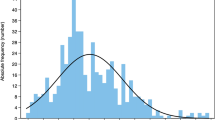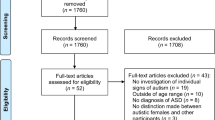Abstract
Forty-two children of at least normal nonverbal intelligence and with a diagnosis of “delayed speech” were subdivided into those having “moderate” and those having “severe” speech difficulties on the basis of the Illinois Test of Psycholinguistic Abilities. Parents of children with “severe” speech difficulties were of much higher social class, and the children were much more likely to have been exposed to potentially traumatic environmental influences than the “moderately” affected children. The “severely” affected probands were also much less likely than the “moderately” affected probands to have relatives with speech disturbances. These data indicate the heterogeneity of the diagnosis of “delayed speech” and suggest parallels to findings in the area of mental retardation, namely, that moderate deficiencies represent the lower end of the normal curve distribution from either a genetic or an environmental perspective, while severe deficiencies are the result of single genes or of serious environmental traumas.
Similar content being viewed by others
References
Allen, G. (1958).Am J. Ment. Defic. 62:840.
Burt, C., and Howard, M. (1956). The multifactorial theory of inheritance and its application to intelligence.Brit. J. Stat. Psychol. 9:95–131.
Duncan, O. D., Featherman, D. L., and Duncan, B. (1968). Socioeconomic Background and Occupational Acheivement: Extensions of a Basic Model, Final Report Project No. 50074 (EO-191), U.S. Department of Health, Education and Welfare Office of Education, Bureau of Research, May.
Erlenmeyer-Kimling, L. and Jarvik, L. F. (1963). Genetics and intelligence: A review.Science 142:1477–1479.
Graves. W. L., Freeman, M. G. and Thompson, J. D. (1968). Culturally related reproductive factors in mental retardation. Paper read at Conference on Sociocultural Aspects of Mental Retardation Peabody College, Nashville, Tenn., June.
Jensen A. R. (1969). How much can we boost IQ and scholastic achievement?” InEnvironment, Heredity, and Intelligence, Reprint Series No. 2, Cambridge, Mass.,Harvard Education Review, pp. 1–123.
Kushlick, A. (1966). Assessing the size of the problem of subnormality. In Meade, J. E., and Parkes, A. S. (eds.)Genetic and Environmental Factors in Human Ability, Plenum Press, New York, pp. 121–147.
McGuire, C., and White, G. (1952). The measurement of social status. Research Paper in Human Development No. 3 (revised) University of Texas, Austin, May.
Pearson, K. (1930–1931). On the inheritance of mental disease.Ann. Eugen. 4:362–380.
Pearson, K., and Jaederholm, C. A. (1913–1914).On the Continuity of Mental Defect. Vol. 2 in the setMendelism and the Problem of Mental Defect ..., Dulau & Co. London.
Penrose, L. S. (1939). Intelligence test scores of mentally defective patients and their relatives.Brit. J. Psychol. 30.
Penrose, L. S. (1963).The Biology of Mental Defect. Sidgwick and Jackson, London.
Roberts, J. A. F. (1940). Studies on a child population. V. The resemblance in intelligence between sibs.Ann. Eugen.,10:293–312.
Roberts, J. A. F. (1952). The genetics of mental deficiency.Eugen. Rev. 44:71–83.
Walker, J. (1966). Pregnancy and perinatal association with mental subnormality. In Meade, J. E., and Parkes, A. S. (eds.),Genetic and Environmental Factors in Human Ability. Plenum Press, New York, pp. 105–119.
Warner, W. L., et al. (1949).Social Class in America: A Manual of Procedure for the Measurement of Social Status, Science Research Associates, Chicago.
Author information
Authors and Affiliations
Rights and permissions
About this article
Cite this article
Byrne, B.M., Willerman, L. & Ashmore, L.L. Severe and moderate language impairment: Evidence for distinctive etiologies. Behav Genet 4, 331–345 (1974). https://doi.org/10.1007/BF01066154
Received:
Accepted:
Issue Date:
DOI: https://doi.org/10.1007/BF01066154




